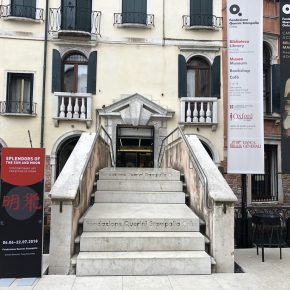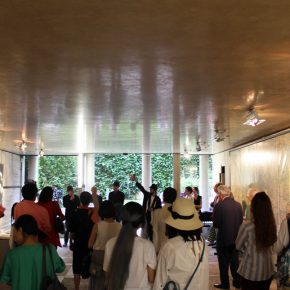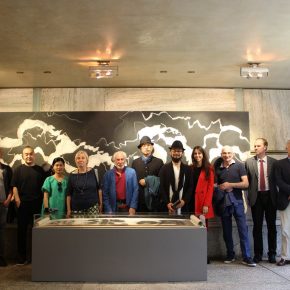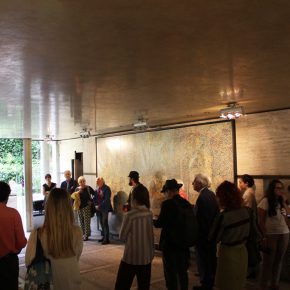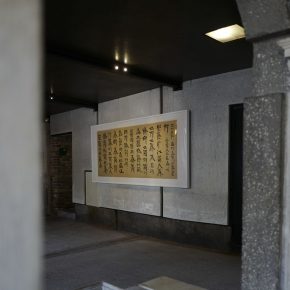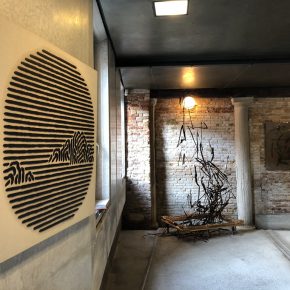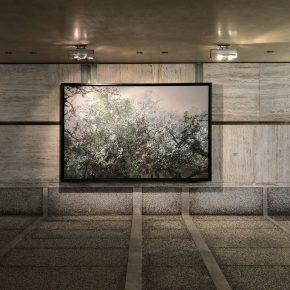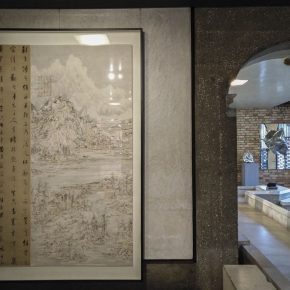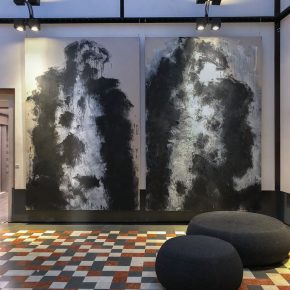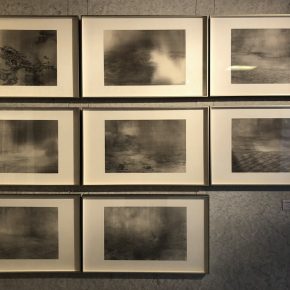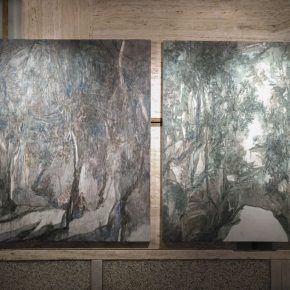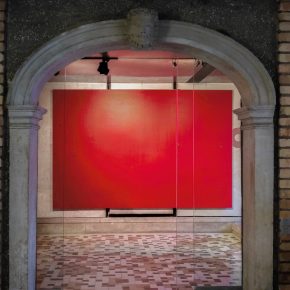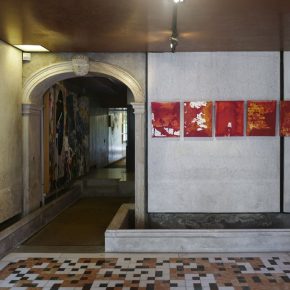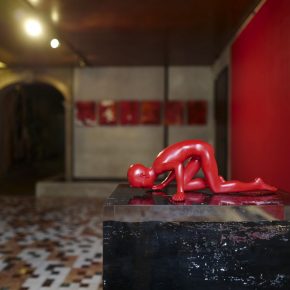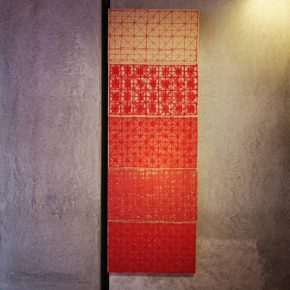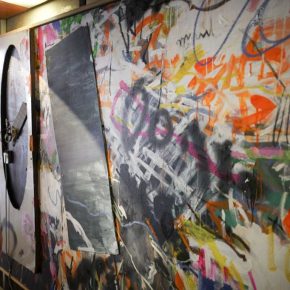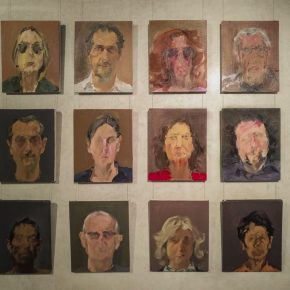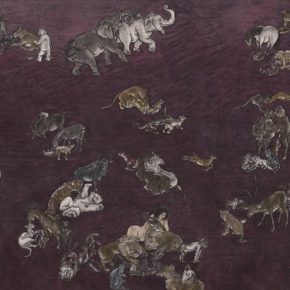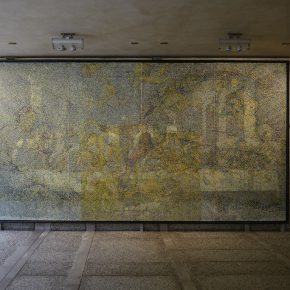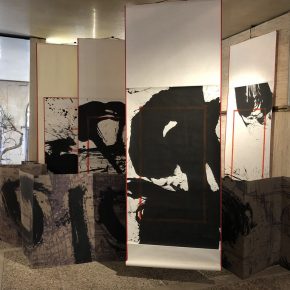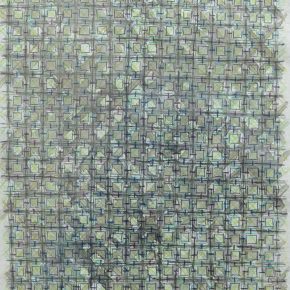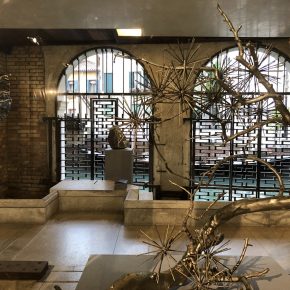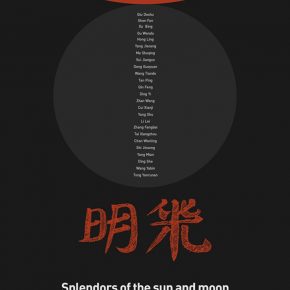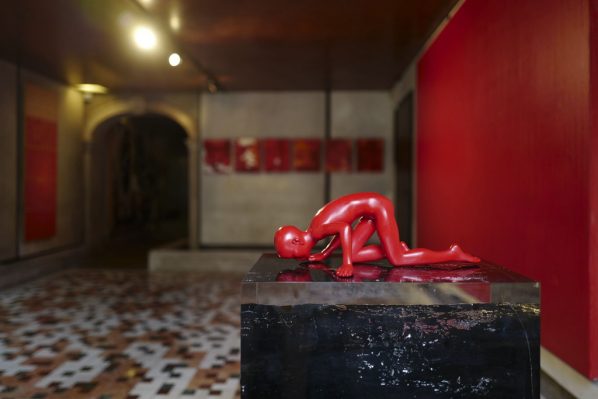
“Splendors of the Sun and Moon, shine day after day” means “splendors of the sun and moon, shining on everything on earth, day in and day out.”
“The sun and moon” are cosmic stars, they refer to the concept of space; the phenomena that sun rises and moon falls, refers to the concept of time; the sun and moon are still integrated as they differ and unify with each other, as a whole from the highest vision of the world. The sun as Yang while the moon as Yin, thus Yin and Yang are both contradictory and unified, in a relationship of mutual creation and destruction. In the alternations of Yin and Yang, everything can be nurtured, and the origin that all matter is indestructible, which are the ways of Heaven, containing grand perspective of time and space, concept of development in the universe. In the thoughts of Chuang-tzu within traditional Chinese culture, Tao is the ultimate principle of the universe while in the traditional philosophical opinion, the noblest realm of life is to seek Taoism, obtain Taoism and get through Taoism. For artists, painting could also be taken as way to “get through Taoism.”
“Splendors” embody the meaning of light and colors, which constitute important elements of paintings. Splendors also have the meaning of shining, opening and soaring, which metaphorically indicates that painting as a form of art ascends to connotation and even to spirit.
Most of the artworks selected for this exhibition are black and white, which are in line with “the sun and moon.” The colors of black and white seem to change into the nature of Heaven Tao, which mutually promote each other, constituting a universe that integrates all matters while showcasing the Eastern philosophy of heaven and earth. “Black” in ancient China also represents heaven, which means long nights without end, and black is the king of all colors. “White” represents light, with a pure and abundant nature. The harmonious nature formed by black and white is a co-existent relationship that constitutes a universal world that integrates with everything on earth. “Red” in ancient dynasties was called “Zhu”, with the meaning of “heart”, when red is added to black, the astronomical atmosphere changes. When the color red is integrated with black, which has a significance with the highlights of civilizations and comprehension of natural laws.
This exhibition has selected artists on the basis of the spiritual connotations mentioned above and invited these outstanding Chinese artists within the international contemporary art world including: Qiu Deshu, Shen Fan, Xu Bing, Gu Wenda, Hong Ling, Yang Jiecang, Ma Shuqing, Sui Jianguo, Deng Guoyuan, Wang Tiande, Tan Ping, Qin Feng, Ding Yi, Zhan Wang, Cui Xianji, Yang Shu, Li Lei, Zhang Fangbai, Tai Xiangzhou, Chen Wenling, Shi Jinsong, Yang Mian, Ding She, Wang Yabin, Tong Yanrunan, etc.
Interpretations on the Exhibits
Qiu Deshu
Qiu Deshu’s “Fission” is dominated by black and white, starting from tearing rice paper, he has created an art language of fission. “Fission” means cracking (destruction) and change (renaissance). It expresses the opinion that inevitable transformations and mutual transformations occur to matters in Chinese traditions. The universe is constantly changing and circulating in transformation.
Shen Fan
Shen Fan’s works are composed of a different series with distinctive appearances, and the materials are constantly changing. However, the works have continued the quality of the ancient Chinese literati art on the visual texture. This work reanalyzes the space and stroke structures of classical landscape paintings. At the same time, in the relationship between new media and space, it reproduces the most important natural, introspective part in literati art, as well as common perceptions of literati art in penetrating the current epoch. Shen Fan’s new work in recent years has returned to the intuition as well as observations on the “identification” of the work, through visual, tactile, textual, and other perceptual modes for transferring, the artist has put forward the comprehensive system of the viewing which also includes his modification and improvement in viewing logic.
Xu Bing
“Square Word Calligraphy” is a written form that the artist Xu Bing created, which looks like Chinese, but it is actually written in English. The content is from the poetry by renowned poet Du Fu in ancient China, forming a dialogue between ancient and modern China and further including foreign countries. The audience who are confronted with “Eastern Calligraphy of English Culture” would gain an unprecedented experience. In such a familiar and strange transition, it provides a field that transcends time and space and further a completely new possibility of experience. The work conveys the artist’s view and attitude toward the relationship between art, society and various cultures.
Gu Wenda
Gu Wenda created “Splendors of the Sun and Moon” which was written in his individualistic calligraphy and refers exactly to the title of this exhibition. This work was also specially produced by the artist for this exhibition. The new exploration and breakthrough of Gu Wenda has been made in contemporary ink and wash paintings which are based on the fusion of these two mature art languages: landscape painting and calligraphy. His achievements in exploring the frontier of contemporary ink and wash paintings have influenced a group of contemporary ink and wash artists. Perhaps when seen as a retrospective in the future, his challenges and expansion in the contemporary ink and wash art movement will make him esteemed as the founder of Chinese contemporary ink and wash art.
Hong Ling
This work portrays the growth under the spring rains in the south of the Yangtze River in March, revealing the natural vitality and charm of earth, forests, flowers and mountains. His images weaken the light and shadow while emphasizing the flowing shadows of the vigorous flowers and trunks of trees. The full composition of the picture emphasizes the power and dynamism of the rhythms and some of the obscure grey feelings convey a sense of gentleness. The painting process emphasizes that the layering and coloring, accumulated layers make them look richer in color and that the continuous generation of painting inspiration guides the formation of imagery and artistic conception.
The artist believes that when creating, he must devote his own creation to Nature, to tradition, and to landscape. In the cities lying behind, the state of people’s struggling livelihood is getting farther and farther away. Along with the strong pulse of traditional Chinese culture, it beats with the landscapes of China. His technique is modern, but his spirit is still the inheritance of traditional Chinese landscape spirit.
Yang Jiecang
“Ziguangtu” comes from one of the series of works of “Decameron”. The artist uses traditional techniques of brushwork to portray a paradise in his imagination. This paradise was created on the basis of the Florentine writer Giovanni Boccaccio’s novel “The Decameron” from the Renaissance period. The artist’s imaginary paradise is free from any restrictions, without authority and violence. He dealt with themes such as material and spiritual transcendence, individual liberation, universal love and nature.
Ma Shuqing
Ma Shuqing focuses on leaving traces of time in his work. He uses two kinds of transparent and opaque materials, which are overlapped by layers of different colors, invisible or transparent. They represent the interweaving of the artist’s rationality and sensibility. In the coverage and covered state, the elapsing time is recorded in his painting. The visual and invisible coexist in the painting process, which is revealed to the viewer bit by bit in the painting.
Sui Jianguo
Sui Jianguo has his unique comprehension on various aspects of art exploration, such as creative ideas, forms, choices of media, processing methods, and space-time experiences and so on. His works dexterously combine concepts and forms, with a strongly symbolic sense, most of these symbols are closely related to the special memory of society and history. His creation gradually drops the identity of the individual and enters into a more macro perspective, from which, we can find a cultural exploration into the concepts of time and space. Meanwhile, Sui Jianguo has successfully brought the work into a comprehensive reflection of modern Chinese art practices.
Deng Guoyuan
His work is made of waste. Under the context of current contemporary art, its complexity is unprecedented. It is difficult to subvert and reconstruct the traditional classic forms, language structures and texts; however, after a long period of thinking, he locates his own “pioneer” on the relationships between “humans and nature”, “humans and art”, and “nature and art”, and it is reborn in new forms through the disposal of waste materials. Therefore, the relationship among man, art, and nature will also change constantly through artificial or individual transformations and generate new relationships.
Wang Tiande
As a contemporary ink and wash practitioner, Wang Tiande has never been stuck in traditional forms. His spacial concept of ink and wash is not only restricted in painting, but it can also be spread in sculpture-like works, burning works, landscape paintings, and calligraphy... transcending time and space.
On the left side of the work is calligraphy from an ancient calligrapher while on the right side the artist uses the method of burning to replace the writing brush and constructs the spatial relationship between the void and solid traces. Hollowed flaming writing covers the underlying calligraphy and landscape painting, resulting in partial hollow lines highlighting the thick ink, with gleaming handwriting or rubbings, incomplete shapes of characters, not only did they seem to have experienced the erosion of years thus these traces of time were left, they also change the conventional forms of traditional paintings and calligraphy and thus form the artist’s overall visual language.
Tan Ping
Tan Ping impressed the audience for he used big blocks of gorgeous red in his work. Red plays an important role in the context of Chinese culture. Red is known in ancient dynasties as “Zhu” and it has the meaning of “heart”. In the book “Heavenly Creations,” it says: “Five conceptions are descending, when red is integrated with black, it becomes the most important. Thousands of scrolls are spread out, when red is added to black, the astronomical atmosphere changes,” therefore it has a deep cultural significance. The form of the image gradually decomposes into a swimming point from a large space-filled circle, and is constantly dissociated from this uncertain balance of time and space. Through the repeated coverage of colors, the surface image is gradually hidden behind the scenes and eventually disappearing from the surging, behind the bright colors, there is another depth and level, with hints and metaphors, meanings and symbols.
Qin Feng (Album)
In Qin Feng’s work, his similarity and unison with the 17th century Chinese painter Badashanren (pseudonym of Zhu Da) can be easily found. Whether with ink and wash or acrylic, he creates dynamic visual forms on paper and canvas, corresponding to similar curiosity and adventurous spirit. His installation works convey his symbolic intention and strong visual effects with strong ink.
Qin Feng (Scroll)
Various forms of experiments on Chinese ink and wash painting are still the focus of Qin Feng’s works. Enlarging the size of his work, trying various colors except for ink, and even taking use of modern acrylic paints, he persistently explore the infinite possibilities of brush and ink languages. Although he keeps changing his creating methods, Qin Feng has also inherited and continued certain traditions. He follows the abstract form in black which people are familiar with, and subtle traces of Chinese landscape painting emerge in this series. Like landscapes in traditional Chinese paintings, these images are the products of artists’ imagination, rather than the direct depiction of the external world.
Ding Yi
As an artist, Ding Yi’s individualistic iconic style lies in that he has persisted in creating his images repeatedly and carefully with “cross” shaped patterns. “Cross” has an important religious significance in the West. In the Chinese context, the “cross” represents the azimuth, direction and time zone, implying the temporal relationship between heaven and earth, the rising sun and falling moon. Ding Yi has explored abstract aesthetics, organized abstractions, and repetitions of changes in patterns, which have made his work particularly fascinating in the context of impartial contemporary abstract paintings and which can arouse people’s curiosity. In his works, those harmonious and consistent “cross” elements visualize the complicated influence of rigorous and dynamic interactions.
Zhan Wang
The flying stone is directly forged from a stainless steel plate on the stone. After carefully developing every detail on the stone, each undulating until it is completely close to the stone, exactly the same. After welding, grinding and polishing, it becomes a mirror-like stone which is the same as the original stone, or a fake stone with a mirror-like material. Finally, it was mounted on a mirror and the mirror was crushed. It comprehensively shows the moment when a stone comes and lands, and all the materials show a reflection without any reserved room. As a mirror, it reflects the changes of the sun and moon, and the relationship between time and space.
Zhan Wang’s stainless steel creations, has long been highly praised by the international art community. In particular, the masterpiece “Jiashanshi” series is based on the Taihu Stone in ancient Chinese gardens as a prototype, using a hand-made method to create a shiny stainless steel rock. Zhan Wang puts less emphasis on meanings but attaches importance to visual impacts from new images, it is not only a metaphor of Utopia but it also stands for a mirror image of modernity, and it profoundly reflects how Chinese contemporary culture reshapes traditional important propositions in the rapidly changing social process.
Cui Xianji (Installation)
Cui Xianji’s installation works have two important elements. One is the moon and the other is the abstract Chinese stereotype. The moon is the moonlight of the “Splendors of the Sun and Moon,” and the red moon is a symbol of romance. Red is called “Zhu” in ancient times. The Chinese stereotype represents the way of communication and is also a symbol of Chinese civilization. The works are displayed using the content of Chinese colors, trying to explore the possibility of communication between Chinese and Western cultures.
Cui Xianji (Painting)
The contemporary artist Cui Xianji extracts the essentials of the “sentimentality”, “straightness” and “truthfulness” from the cursive calligraphy, and integrates them into the contemporary painting art creation. His “cursive calligraphy” is detached from the use of words and is unreadable. Only the visual elements are extracted from the calligraphy, only the most instinctive sensibility is extracted. It can be said that this is an enthusiastic abstraction of Eastern art philosophy that resonates with the world with its unique context.
Yang Shu
Lights and colors in his work indicate the sensuous splendor in paintings, and they interpret the relationship between shapes and colors in paintings. Being different from Western abstract art in the traditional sense, as a contemporary painter who has experienced the changes of Chinese contemporary art for 30 years, Yang Shu is accustomed to taking abstract ideas and actions traces first as a means to get rid of the painterly restraint, with an humanistic complexity in his intellectual character, he has unintentionally infused the Eastern spiritual connotation “Great form is beyond shape” into his work.
Li Lei
Splendor, is the origin of life. This splendor does not refer to the colorful and warm shine sent out by the sun. This splendor is sent out from the mind, or it is sent out by the spirit. It can also be said that splendor constitutes the essence of life. The artist is in pursuit of this light, and although he still uses his eyes to feel the light of the sun, what the eyes see is actually the appearance of light on the mind. Painting the sun and the inner part of the sun is actually an analysis of the artist’s inner self.
Zhang Fangbai
The artist paints specimens of eagles through oil painting materials, with black and white as his basic tone while the significance of Eastern ink and wash paintings are contained in his work. It is through the artist’s long-term comprehension of Chinese ink and wash, inscriptions, and lines that he gradually formed the shaggy lines and solidified shapes in his paintings. There is Zen in his abstract forms. The artist thinks that the pursuit of individualistic modelling in paintings and the down-to-earth labor can better approach the spirit of the Tao and the origin of art.
Tai Xiangzhou
The series “Cosmic Symphonies” expands Ma Yuan’s “Painting of Water” in black and white monochrome. Ma Yuan is the most accomplished painter of ancient Chinese painting. Water is a symbol of wisdom and sages in Lao-tzu and Chuang-tzu philosophy. The artist uses water as an element to uplift water as the carrier of material principles such as waves, fluidity, and state of matter. The long scroll, “Microcosm-Microcosm,” derives a prehistoric world from the small stones on the desk. Tai Xiangzhou’s Song-styled works create a virtual art history: if the techniques and conventions of landscape painting in the Song Dynasty have not changed, how will it reflect the universe from the point of view of contemporary people?
Chen Wenling
He has a distinctive style and his works are filled with an inner tension. The creative motif of the “Red Memories” comes from the artist’s childhood memory in his hometown in Fujian and the extraction and refinement of the universal human nature from the children that grew up in that special age, the artist has made every effort to create a natural and naive, happy and naughty red boy; and tried to make “little red boy” contrast with the nervous, anxious, fearful, pretentious, and extremely profit-seeking state of adults in the real world.
Shi Jinsong
Shi Jinsong is a representative of contemporary artists after the 1990s in China. Since 2005, he began to collect withered branches and debris from fallen trees, and he directly used screws, screw arbors and other international standard links to assemble them into various tree styles with traditional Chinese literati aesthetics as a spiritual symbol of corporeality. This provides an Eastern perspective and opportunity for the globalized era.
He takes advantage of waste materials and withered natural objects, which indicates that everything in the world is in a cycle and everything is immortal. From the internal self-cultural perspective to the external cultural production and practice, these form an unique aesthetic system, either to convey an individual atmosphere of the self, or connect “directly” with various cultures in the world, this is the harmony between humans and nature in the Eastern temperament and the aesthetic realm in traditions.
Yang Mian
CMYK–“Renaissance Painting” is the latest series of works created by Yang Mian with the four colors CMYK dots he invented by himself. This belongs to his newest series of 13 pieces “CMYK–From Pre-Renaissance to Pop Art”, the work chose to use widespread prints of three masterpieces in the Renaissance–Da Vinci’s “The Last Supper,” Michelangelo’s “The Creation of Adam,” Raphael’s “Triumph of Galatea,” the artist recreated with the dots of four colors (CMYK), and then reattached them together to present the Renaissance paintings conveyed through the media, allowing the audience to comprehend this work, thus recognize and think about our philosophical theories on the universe, life, religion, etc.
Ding She
Ding She’s abstract painting focuses on the identification and inquiry about the value of human existence, as well as the exploration and expression of the universe and the world. The continuous repetition of the red intersected figures depicting red in the ancient language is also a symbol of the heart. Repeated painting like a spiritual practice and it makes us experience a wonderful, peaceful, stirring, dynamic and impressing strength. He combined seemingly disordered dots and lines, and wove out new visual texts. With a brand-new visual language, he has reconstructed a new visual realm. With simple dots and lines, he creates a vast space. The infinity presented in his painting is thought-provoking and also implies a cosmological thinking similar to Chinese Zen.
Wang Yabin
A lush, vibrant and abstract forest in monochrome was constructed in the work. The delicate blank area becomes the light between trees, shining from the darkness, forming a deep and serene composition in space. The plain content with rich and subtle, unrestrained, arbitrary ink touches but with everlasting appeal, and the seemingly familiar but unexpected dreamy images float, making the black and white world have thousands of presentations, which have been endowed with an unique charm of primitive simplicity that is naive and natural.
Tong Yanrunan
Tong Yanrunan’s works are different from the imitation of Meitu style, but he brings the audience back to the beginning of the universe that connects heaven and earth by throwing away external modifications. In considering a retrospective of himself from the image, he enters into deep reflections on the relationship with all the beings and the universe, returning to the true self, he gains a new kind of original motivation and reflects on his life to achieve spiritual tranquility. During 20 years of persistent practices, he adheres to the creative way of face-to-face sketching, to interpret the spirit of Chinese landscape, and his work is an overall reflection of art in the internet era while he develops a school of his own in the world of art.
Courtesy of the organizer.


